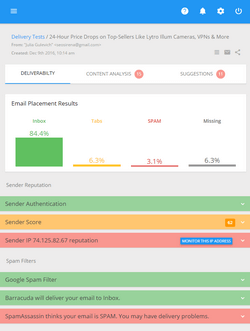Anti-Spam Filters in Email Clients and Web Mail Services
Along with the ISP spam filtering systems, people can use anti-spam filters in their email clients to protect against unsolicited emails. In the table below we summarized the information about anti-spam filters in most popular email applications and web-based email services.
- AOL. Takes spam very seriously. You have to make sure your emails look relevant, or people will click on “Report Spam” button (even if they opted in to your list!). AOL 9.0 has new adaptive filters, which learn the types of email the recipient marks as spam. There are also user configurable filters, allowing users filter out words or domains they do not want.
- Apple Mail. Comes with its own spam filtering system that “learns” so you should test your emails for any deliverability issues.
- Outlook 2000. Predates all the vicious worms, spam, and viruses that we’re used to now, so more of your emails with flash and videos and crazy stuff will actually work here.
- Outlook 2003. Predates all the vicious worms, spam, and viruses that we’re used to now, so more of your emails with flash and videos and crazy stuff will actually work here.
- Outlook Express. Has a user definable setting to automatically block the images and attachments that may contain viruses.
- Mozilla Thunderbird. Has a feature that tries to detect “scams,” where they look for hyperlinks that claim to point to a website, but the code actually links you somewhere else. If it detects a potential “scam,” you get a warning across the top of the message, saying “Thunderbird thinks this message is a scam.” You can click the “Not a scam” button if it was a false alarm. It’s a nice idea, but it seems to give lots of false positives, especially when you use click tracking in your emails (all your links will point to a redirect script, in order to track clicks).
- Yahoo!Mail. Has pretty aggressive anti-spam filters. Other than that, they do the typical browser-based email stuff, like stripping your BODY and HEAD tags.
- Gmail. Uses extremely aggressive spam filters. And very, very little CSS support. It strips embedded CSS, (even if you keep the CSS out of the tag). It also strips every “class” code that it finds (such as in ). To get CSS to work in Gmail, you’ll need to use inline styles.
Table of contents | Page list for this chapter | Next page

